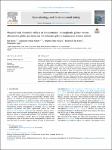Physical and chemical effects of conventional microplastic glitter versus alternative glitter particles on a freshwater plant (Lemnaceae: Lemna minor)
| dc.contributor.author | Boots, B | |
| dc.contributor.author | Green, DS | |
| dc.contributor.author | Olah-Kovacs, B | |
| dc.contributor.author | De Falco, Francesca | |
| dc.contributor.author | Lupo, E | |
| dc.date.accessioned | 2023-11-01T16:12:57Z | |
| dc.date.available | 2023-11-01T16:12:57Z | |
| dc.date.issued | 2023-09 | |
| dc.identifier.issn | 0147-6513 | |
| dc.identifier.issn | 1090-2414 | |
| dc.identifier.other | 115291 | |
| dc.identifier.uri | https://pearl.plymouth.ac.uk/handle/10026.1/21513 | |
| dc.description.abstract |
Glitters are primary microplastics which are directly littered into the environment, yet the ecological effects have seldom been tested. When microplastics enter the environment, their physical presence and chemical leachate may alter the physiology of primary producers. Glitter can be composed of plastic or natural and/or biodegradable materials, often with additives. Three experiments were run for 14 days to separate chemical and physical effects of different types of glitter: polyethylene terephthalate (PET), biodegradable modified regenerated cellulose (MRC), synthetic mica, and a natural particle control (kaolinite) on several physical characteristics of Lemna minor (common duckweed). L. minor was exposed to either fresh (chemical and physical effects), leachate from glitter (chemical) or aged glitter (physical). Overall, there was little effect of PET, synthetic mica, kaolinite or of any aged glitter. High concentrations of fresh MRC glitters, however, decreased root length, biomass and chlorophyll content of L. minor. Some of these effects were also present when exposed to leachate from MRC glitters, but were less pronounced. Elemental analysis revealed the presence of metals in MRC glitters which may explain these responses. Short-term ecotoxicity of biodegradable glitters can arise due to their physical and chemical properties, but may lessen over time as their surface coating degrades. | |
| dc.format.medium | Print-Electronic | |
| dc.language | en | |
| dc.publisher | Elsevier BV | |
| dc.subject | Ecotoxicology | |
| dc.subject | Biodegradable plastics | |
| dc.subject | Modified regenerated cellulose | |
| dc.subject | Synthetic mica | |
| dc.subject | Lemna minor | |
| dc.title | Physical and chemical effects of conventional microplastic glitter versus alternative glitter particles on a freshwater plant (Lemnaceae: Lemna minor) | |
| dc.type | Journal Article | |
| plymouth.author-url | https://www.webofscience.com/api/gateway?GWVersion=2&SrcApp=PARTNER_APP&SrcAuth=LinksAMR&KeyUT=WOS:001048980200001&DestLinkType=FullRecord&DestApp=ALL_WOS&UsrCustomerID=11bb513d99f797142bcfeffcc58ea008 | |
| plymouth.volume | 263 | |
| plymouth.publication-status | Published | |
| plymouth.journal | Ecotoxicology and Environmental Safety | |
| dc.identifier.doi | 10.1016/j.ecoenv.2023.115291 | |
| plymouth.organisational-group | |Plymouth | |
| plymouth.organisational-group | |Plymouth|Faculty of Science and Engineering | |
| plymouth.organisational-group | |Plymouth|Faculty of Science and Engineering|School of Geography, Earth and Environmental Sciences | |
| plymouth.organisational-group | |Plymouth|Users by role | |
| plymouth.organisational-group | |Plymouth|Users by role|Academics | |
| dc.publisher.place | Netherlands | |
| dcterms.dateAccepted | 2023-07-20 | |
| dc.date.updated | 2023-11-01T16:12:57Z | |
| dc.rights.embargodate | 2023-11-02 | |
| dc.identifier.eissn | 1090-2414 | |
| rioxxterms.versionofrecord | 10.1016/j.ecoenv.2023.115291 |


